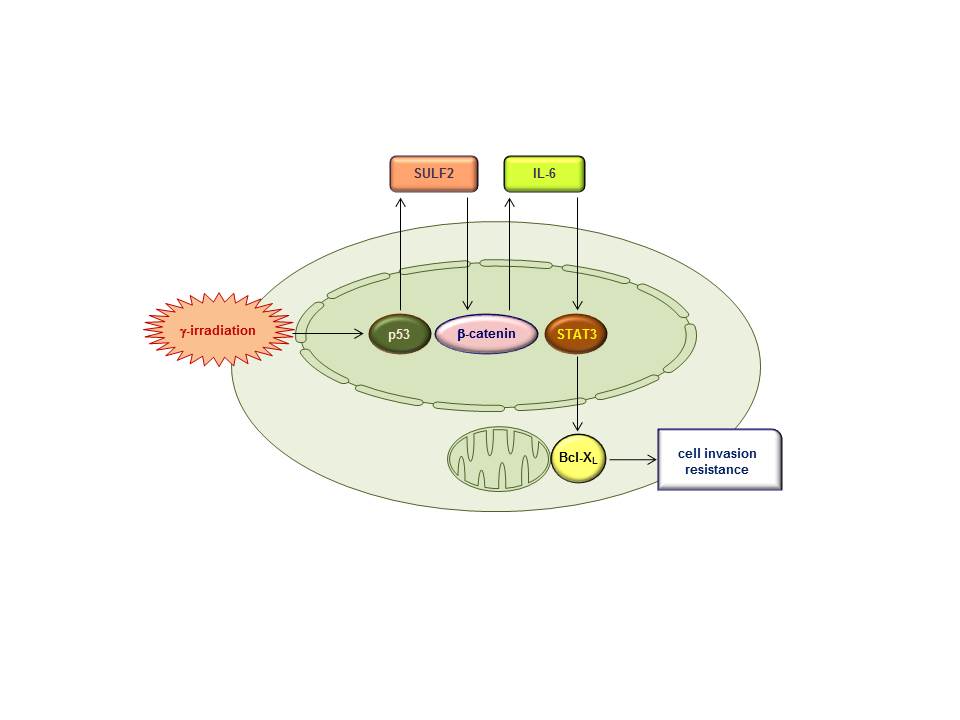글로벌 연구동향
방사선생물학
![[Oncotarget. ] Involvement of SULF2 in γ-irradiation-induced invasion and resistance of cancer cells by inducing IL-6 expression.](/enewspaper/upimages/admin_20160414113817_R.jpg) [Oncotarget. ] Involvement of SULF2 in γ-irradiation-induced invasion and resistance of cancer cells by inducing IL-6 expression.
[Oncotarget. ] Involvement of SULF2 in γ-irradiation-induced invasion and resistance of cancer cells by inducing IL-6 expression.KIRAMS/정찬헌, 엄홍덕*
- 출처
- Oncotarget.
- 등재일
- 2016 Feb 17.
- 저널이슈번호
- doi: 10.18632/oncotarget.7449.
- 내용

AbstractCancer cells that survive radiotherapy often display enhanced invasiveness and resistance to death stimuli. Previous findings have suggested that ionizing radiation (IR) induces such undesirable effects by stimulating the STAT3/Bcl-XL pathway. To identify novel cellular components that mediate these actions of IR, we irradiated lung cancer cells with sublethal doses of ð-rays and screened for the induction of IR-responsive genes by microarray analysis. The genes encoding 2 extracellular proteins, SULF2 and IL-6, were found to be upregulated, and these results were confirmed by polymerase chain reactions and western blot analyses. Because the IR-mediated induction of SULF2 was a novel finding, we also confirmed the phenomenon in vivo using xenograft tumors in mice. Analyses of signaling processes revealed that IR induced SULF2 expression via p53, which then promoted IL-6 expression by stabilizing β-catenin, followed by stimulation of the STAT3/Bcl-XL pathway. Consistently, both SULF2 and IL-6 mediated IR-induced invasion and resistance to death stimuli. To investigate whether SULF2 contributes to IR-induced tumor metastasis, we irradiated tumors in mice with sublethal doses of IR. This treatment promoted the entry of tumor cells into the blood stream (intravasation), which was abolished by downregulating SULF2 expression in tumor cells. These results demonstrated that SULF2 can mediate the detrimental effects of IR in vivo. Therefore, SULF2 may be potentially used as a therapeutic and diagnostic target to predict and overcome the malignant effects of IR, particularly in tumors expressing p53 wild-type.
Author information
Jung CH1, Ho JN1,2, Park JK1, Kim EM1, Hwang SG1, Um HD1.
1Division of Radiation Cancer Biology, Korea Institute of Radiological & Medical Sciences, Seoul 01812, Korea.
2Present address: Biomedical Research Institute, Department of Urology, Seoul National University Bundang Hospital, Seongnam 463-707, Korea.
- 키워드
- IL-6; SULF2; cancer invasion; radiotherapy; resistance
- 연구소개
- 암 치료의 최대 장애는 암세포의 저항성과 전이입니다. 이는 방사선치료에도 해당되는 것으로 방사선치료에서 생존한 암세포는 항암 저항성과 전이력이 증가될 수도 있습니다. 본 연구에서는 이 현상의 기전을 분석하여 방사선 처리 시 암세포에서 SULF2 라는 물질이 분비되어 암세포 전이와 저항성이 증가됨을 확인하였습니다. 따라서 방사선치료 후 전이 재발을 방지하기 위해서는 SULF2의 작용을 차단할 필요성이 대두되는데 이점에서 SULF2가 세포 안에 머물지 않고 세포 밖으로 분비된다는 것이 큰 이점이 됩니다. 즉, 암세포 안에 숨어 있는 것보다는 혈액에 존재하는 SULF2를 공략하는 것이 기술적으로 훨씬 용이할 뿐만 아니라 이를 이용하여 방사선치료 예후도 평가가 가능해 보입니다. 이를 위한 실용화 연구를 현재 수행중입니다.
- 덧글달기









